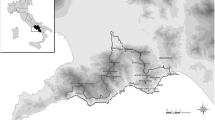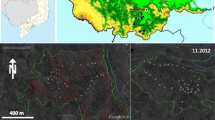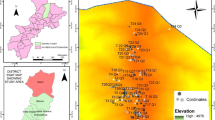Abstract
This investigation was carried out between 2019 and 2020 to reveal the forest vegetation of Beşpare villages in Artvin. This vegetation has been studied according to the conventional Braun-Blanquet approach. A total of 96 relevés were sampled. The cover-abundance of plant species and environmental data in plots were analyzed using multivariate analyses techniques. Raunkiaer life-form ratios, Shannon–Wiener index values, species richness, and chorological spectrum of syntaxa were calculated and interpreted. EUNIS habitat code and names for described syntaxa were assigned. In the area under review, forest vegetation is represented by Querco polycarpo-Piceetum orientalis ass., Carpino orientali-Quercetum polycarpae ass., Carpino betuli-Piceetum orientalis ass., Thelypterido limbospermae-Alnetum barbatae ass., Rubo caucasici-Fagetum orientali ass., Fago orientalis-Abietum nordmannianae ass., Fago orientalis-Piceetum orientalis ass., Abieti nordmanniana-Piceetum orientalis ass., Pino sylvestris-Piceetum orientalis ass. Two new plant associations were identified. Some previously defined syntaxa names have been re-arranged according to The International Code of Phytosociological Nomenclature.





Similar content being viewed by others
Data availability
Not applicable.
Code availability
ECOM software program for canonical correspondence analysis (CCA). EUNIS the European Nature Information System. ICPN the International Code of Phytosociological Nomenclature rules, 4th edition. I.M. The Interpretation Manual of European Union Habitats—EUR28 determines the EUNIS habitat types of plant associations. SPSS (Statistical Package for the Social Sciences) software program for graphic drawing and statistical evaluation.
References
Akman Y (1999) Climate and Bioclimate, the methods of bioclimate and climate types of Turkey. Kariyer Press, Ankara
Bayraklı F (1987) Plant and soil analyses, No. 17. Ondokuz Mayıs University Press, Samsun
Beers TW, Dress PE, Wensel CL (1966) Aspect transformation in site productivity research. J Forest 64(1):691–692
Benavides R, Scherer-Lorenzen M, Valladares F (2019) The functional trait space of tree species is influenced by the species richness of the canopy and the type of forest. Oikos 128(10):1435–1445. https://doi.org/10.1111/oik.06348
Braun-Blanquet J (1932) Plant Sociology. McGraw-Hill, New York and London
Browicz K (1989) Chorology of the Euxinian and Hyrcanian element in the woody flora of Asia. Plant Syst Evol 162(1):305–314
Canedoli C, Ferrè C, El Khair DA, Comolli R, Liga C, Mazzucchelli F, Proiettoa A, Rotaa N, Colomboa G, Bassanob B, Viterbib R, Padoa-Schioppa E (2020) Evaluation of ecosystem services in a protected mountain area: soil organic carbon stock and biodiversity in alpine forests and grasslands. Ecosyst Serv 44:101135. https://doi.org/10.1016/j.ecoser.2020.101135
Chytrý M, Tichý L, Holt J, Botta-Dukát Z (2002) Determination of diagnostic species with statistical fidelity measures. J Veg Sci 13:79–90. https://doi.org/10.1111/j.1654-1103.2002.tb02025.x
Çoban S, Willner W (2019) Numerical classification of the forest vegetation in the Western Euxine Region of Turkey. Phytocoenologia 49:71–106. https://doi.org/10.1127/phyto/2018/0274
Davis PH (1965–1985) Flora of Turkey and the East Aegean Islands, 1–9. Edinburgh University Press, Edinburgh
Davis PH, Mill RR, Tan K (1988) Flora of Turkey and the East Aegean Islands (Suppl. 1). 10. Edinburgh University Press, Edinburgh
Dimopoulos P, Raus T, Bergmeier E, Constantinidis T, Iatrou G, Kokkini S, Strid A, Tzanoudakis D (2013) Vascular plants of Greece. An annotated checklist. Botanic gardens and botanical museum Berlin-Dahlem, Berlin and Hellenic botanical society Athens
Douda J (2008) Formalized classification of the vegetation of alder carr and floodplain forests inthe Czech Republic. Preslia 80:199–224
Düzenli A (1982) Investigation of Tiryal Mountain (Artvin) in terms of plant ecology and plant sociology. Habilitation thesis, Ankara University. [Tiryal Dağı’nın (Artvin) bitki ekolojisi ve bitki sosyolojisi yönünden araştırılması. Doçentlik tezi, Ankara Üniversitesi], Ankara
Eminağaoğlu Ö, Kutbay HG, Bilgin A, Yalçın E (2006) Contribution to the phytosociology and conservation of tertiary relict species in northeastern Anatolia (Turkey). Belg J Bot 139:124–130
Eminağaoğlu Ö, Anşin R, Kutbay HG (2007) Forest vegetation of Karagöl-Sahara National Park Artvin-Turkey. Turk J Bot 31(5):421–449
Eminağaoğlu Ö, Göktürk T, İskender H, Eminağaoğlu Z, Turgut H, Erşen Bak F, Yüksel E, Gültekin H, Bayyurt G, Akay A, Akhanlı İ (2020) Beşpare Artvin’de ekoköy olma yolunda projesi, DOKA Projesi, Final Raporu (Beşpare on the way to become an ecovillage in Artvin project, DOKA Project, Final Report)
Eminağaoğlu Ö (2015) Native plants of Artvin. Promat, İstanbul
Gattinger T (1962) Explonatory text of geological map of Turkey, Publication no 36, Mineral Research and Exploration Institute. [Türkiye jeolojik haritası keşif metni, Yayın no 36, Maden Tetkik ve Arama Enstitüsü], Ankara
Gillison AN (2019) Plant functional indicators of vegetation response to climate change, past present and future: II. Modal plant functional types as response indicators for present and future climates. Flora 254:31–58. https://doi.org/10.1016/j.flora.2019.04.001
Goginashvili N, Togonidze N, Tvauri I, Manvelidze Z, Memiadze N, Zerbe S, Asanidze Z (2021) Diversity and degradation of the vegetation of mountain belt forests of central Adjara (the Lesser Caucasus) Georgia. J for Sci 67(5):219–241
Grossheim AA (1939–1967) Flora Kavkaza, 1–7. Baku and Leningrad
Güner A, Özhatay N, Ekim T, Kaya HCB (2000) Flora of Turkey and the East Aegean Islands (suppl. 2) 11. Edinburgh University Press, Edinburgh
Güner A, Aslan S, Ekim T et al (2012) List of Turkish plants (vascular plants) [Türkiye bitkileri listesi (damarlı bitkiler)]. 1st ed. Nezahat Gökyiğit Botanik Bahçesi ve Flora Araştırmaları Derneği, İstanbul
Güner A, Kandemir A, Menemen Y et al (2018) Resimli Türkiye florası Cilt. 2 [Illustrated flora of Turkey]. ANG vakfı Nezahat Gökyiğit Botanik Bahçesi, İstanbul
IBM Corp. Released (2012). IBM SPSS statistics for windows, version 21.0. Armonk, NY
Karadžić B (2018) Beech forests (order Fagetalia sylvaticae Pawlowski 1928) in Serbia. Botanica Serbica 42(1):91–107. https://doi.org/10.5281/zenodo.1173560
Karaköse M (2019) Numerical classification and ordination of Esenli (Giresun) forest vegetation. Biologia 74:1441–1453. https://doi.org/10.2478/s11756-019-00321-z
Karaköse M, Terzioğlu S (2021) Numerical classification and ordination of Finike (Antalya) forest vegetation. Biologia 76(12):3631–3645. https://doi.org/10.1007/s11756-021-00910-x
Kavgacı A, Arslan M, Bingöl Ü, Erdoğan N, Čarni A (2012) Classification and phytogeographical differentiationof oriental beech forests in Turkey and Bulgaria. Biologia 67:461–473
Ketzkhoveli NN and Gagnidze RI (1971–2001) Georgian flora (Flora of Georgia), 1–13. Metsniereba, Tbilisi
Komarov VL (1934–1978) Flora of the USSR 1–24. Leningrad. (English translation by IPST 1–24), Jerusalem
Korkmaz H, Engin A, Kutbay HG, Yalçın E (2011) A syntaxonomical study on the scrub, forest, and steppe vegetation of the Kızılırmak valley. Turk J Bot 35:121–165. https://doi.org/10.3906/bot-0908-152
Lazarina M, Charalampopoulos A, Psaralexi M et al (2019) Diversity patterns of different life forms of plants along an elevational gradient in Crete. Greece Diversity 11(10):200. https://doi.org/10.3390/d11100200
Maes SL, Perring MP, Depauw L, Bernhardt-Römermann M et al (2020) Plant functional trait response to environmental drivers across European temperate forest understorey communities. Plant Biol 22(3):410–424. https://doi.org/10.1111/plb.13082
Mahler S, Shatilova I, Bruch AA (2022) Neogene long-term trends in climate of the Colchic vegetation refuge in Western Georgia-Uplift versus global cooling. Rev Palaeobot Palyno 296:104546. https://doi.org/10.1016/j.revpalbo.2021.104546
Mancheno CSM, Nakhutsrishvili G, Zazanashvili N (2013) A perspective on ecological corridor for maintaining healthy ecological processes in the Caucasus. In 5th Symposium for Research in Protected Areas 10 523–526
McAleece N, Gage JDG, Lambshead PJD, Paterson GLJ (1997) BioDiversity professional statistics analysis software version 2.0, Scottish Association for Marine Science, Scotland, UK
Moradi H, Naqinezhad A, Siadati S, Yousefi Y, Attar F, Etemad V, Reif A (2016) Elevational gradient and vegetation-environmental relationships in the central Hyrcanian forests of northern Iran. Nord J Bot 34(1):1–14. https://doi.org/10.1111/njb.00535
Moradi A, Afsharzadeh S, Hamzehee B, Mozaffarian V (2020) Study of plant diversity and floristics in the westernmost Hyrcanian forests. J for Res 31(5):1589–1598. https://doi.org/10.1007/s11676-019-00949-2
Mucina L, Bültmann H, Dierßen K et al (2016) Vegetation of Europe: hierarchical floristic classification system of vascular plant, bryophytes, lichen, and algal communities. Appl Veg Sci 19(1):3–264. https://doi.org/10.1111/avsc.12257
Mueller-Dombois D, Ellenberg H (2002) Aims and methods of vegetation ecology. The Blackburn, New Jersey
Müller A, Schneider UA, Jantke K (2018) Is large good enough? Evaluating and improving representation of ecoregions and habitat types in the European Union’s protected area network Natura 2000. Biol Conserv 227:292–300. https://doi.org/10.1016/j.biocon.2018.09.024
Nakhutsrishvili G (2013) The vegetation of Georgia (South Caucasus). Springer, Berlin
Nakhutsrishvili G, Zazanashvili N, Batsatsashvili K, Montalvo CS (2015) Colchic and Hyrcanian forests of the Caucasus: similarities, differences and conservation status. Flora Mediterranea 25:185–192. https://doi.org/10.7320/FlMedit25SI.185
Nakhutsrishvili G, Abdaladze O, Batsatsashvili K (2021) Ecological gradients (West-East) and vegetation of the Central Great Caucasus. Bocconea 29:157–168. https://doi.org/10.7320/Bocc29.157
Nakhutsrishvili G, Zazanashvili N, Batsatsashvili K (2011) Regional profile: Colchic and Hyrcanic temperate rainforests of the Western Eurasian Caucasus. In: DellaSala DA (ed) Temperate and boreal rainforests of the World. Island Press, Washington
Necer A, Tadjine A, Belouahem-Abed D, Saoudi M (2019) Vegetation heterogeneity of black alder forests in and around El-Kala Biosphere reserve, northeastern Algeria. Bot Sci 97(1):13–34
Novák P, Zukal D, Kalníková V, Chytrý K, Kavgacı A (2019) Ecology and syntaxonomy of colchic forests in south-western Georgia (Caucasus region). Phytocoenologia 49(3):231–248. https://doi.org/10.1127/phyto/2019/0250
Novák P, Zukal D, Harásek M, Vlčková P, Abdaladze O, Willner W (2020) Ecology and vegetation types of oak-hornbeam and ravine forests of the Eastern Greater Caucasus. Georgia Folia Geobot 55(4):333–349. https://doi.org/10.1007/s12224-020-09386-0
Novák P, Stupar V, Kalníková V (2021) Carpinus orientalis forests in Georgian Colchis: first insights. Tuexenia 41:37–51
Özhatay N, Byfield A, Atay S (2003) Important plant areas of Turkey. WWF, Turkey
Özhatay N, Byfield A, Atay S (2005) Turkey's 122 important plant areas. WWF, Turkey
Poulos HM, Camp AE (2010) Topographic influences on vegetation mosaics and tree diversity in the Chihuahuan Desert Borderlands. Ecology 91(4):1140–1151
Quézel P, Barbéro M, Akman Y (1980) Contribution à l’étude de la végétation forestièred’ Anatolie septentrionale. Phytocoenologia 8:365–519. https://doi.org/10.1127/phyto/8/1980/365
Sanczuk P, Govaert S, Meeussen C et al (2020) Small scale environmental variation modulates plant defence syndromes of understorey plants in deciduous forests of Europe. Global Ecol Biogeogr 30:205–219. https://doi.org/10.1111/geb.13216
Seaby RMH, Henderson PA (2007a) Community analysis package (CAP 4). Version 4.1.3. Pisces Conservation Ltd., Lymington, UK
Seaby RMH, Henderson PA (2007b) Environmental community analysis (ECOM II) version 2.1.3.137. Pisces Conservation Ltd., Lymington, UK
Shatilova I, Mchedlishvili N, Rukhadze L, Kvavadze E (2011) The history of the flora and vegetation of Georgia. Georgian national museum, Institute of paleobiology, Tbilisi
Sundqvist MK, Sanders NJ, Wardle DA (2013) Community and ecosystem responses to elevational gradients: processes, mechanisms, and insights for global change. Annu Rev Ecol Evol Syst 44:261–280
Theurillat JP, Willner W, Fernández-González F et al (2021) International code of phytosociological nomenclature 4th edition. Appl Veg Sci 241:e12491. https://doi.org/10.1111/avsc.12491
Tichý L (2002) JUICE, software for vegetation classification. J Veg Sci 13:451–453. https://doi.org/10.1111/j.1654-1103.2002.tb02069.x
TKH (1990) Artvin province land presence. General directorate of agriculture and rural services press. [Artvin ili Arazi Varlığı. Tarım ve Köy Hizmetleri Genel Müdürlüğü Yayınları], Ankara
Tordoff AW, Zazanashvili N, Bitsadze M et al (2009) CEPF Investment in the Caucasus Hotspot. In: Zazanashvili N, Mallon D (eds) Status and protection of globally threatened species in the Caucasus. CEPF, WWF. Contour Ltd., Tbilisi, 9–15
URL 2. http://www.ipni.org/
URL3.http://ec.europa.eu/environment/nature/legislation/habitatsdirective/docs/Int_Manual_EU28.pdf
URL 4. https://eunis.eea.europa.eu/habitats-code-browser.jsp
Van Der Maarel E (1979) Transformation of cover-abundance values in phytosociology and its effects on community similarity. Vegetatio 39(2):97–114
Varol Ö, Karaer F, Terzioğlu S, Kutbay HG (2003) Phytosociological investigations of Pinus pinea L., forests in the north-east Anatolia region (Trabzon and Artvin-Turkey). Pak J Bot 35(4):587–595
Willner W, Theurillat JP, Pallas J, Mucina L (2015) On the nomenclature of some high-rank syntaxa of European forest vegetation. Phytocoenologia 45(1–2):175–181. https://doi.org/10.1127/phyto/2015/0036
Yıldırım C, Yalçın E, Cansaran A, Korkmaz H (2019) Syntaxonomic analysis of forests shrubs and steppes of Tavşan Mountain Amasya Turkey. Turk J Bot 43(3):409–419. https://doi.org/10.3906/bot-1809-18
Zazanashvili N, Sanadiradze G, Garforth M, Bitsadze M et al (2020) Ecoregional conservation plan for the Caucasus. WWF, KfW, Tbilisi
Zohary M (1973) Geobotanical foundations of the Middle East 1–2 Gustav Fischer Verlag, Amsterdam
Acknowledgements
We thank the staff of the Artvin (Türkiye) Regional Directorate of Forestry for their valuable contribution to this study.
Funding
The authors did not receive support from any organization for the submitted work.
Author information
Authors and Affiliations
Contributions
The study conception was designed by ÖE. Material preparation, data collection, and analysis were performed by ÖE, EY and MSA. EY wrote the first draft of the manuscript. EY revised the manuscript and all authors commented on the early versions of the manuscript.
Corresponding author
Ethics declarations
Conflict of interest
The authors declare that they have no conflict of interest or competing interest.
Consent for publication
All listed co-authors have approved the manuscript before submission.
Additional information
Publisher's Note
Springer Nature remains neutral with regard to jurisdictional claims in published maps and institutional affiliations.
Supplementary Information
Below is the link to the electronic supplementary material.
Rights and permissions
Springer Nature or its licensor holds exclusive rights to this article under a publishing agreement with the author(s) or other rightsholder(s); author self-archiving of the accepted manuscript version of this article is solely governed by the terms of such publishing agreement and applicable law.
About this article
Cite this article
Eminağaoğlu, Ö., Yalçın, E. & Özkaya, M.S. Forest vegetation of the Beşpare ecovillages in the western lesser Caucasus corridor (Artvin/Türkiye). Rend. Fis. Acc. Lincei 33, 739–756 (2022). https://doi.org/10.1007/s12210-022-01095-4
Received:
Accepted:
Published:
Issue Date:
DOI: https://doi.org/10.1007/s12210-022-01095-4




